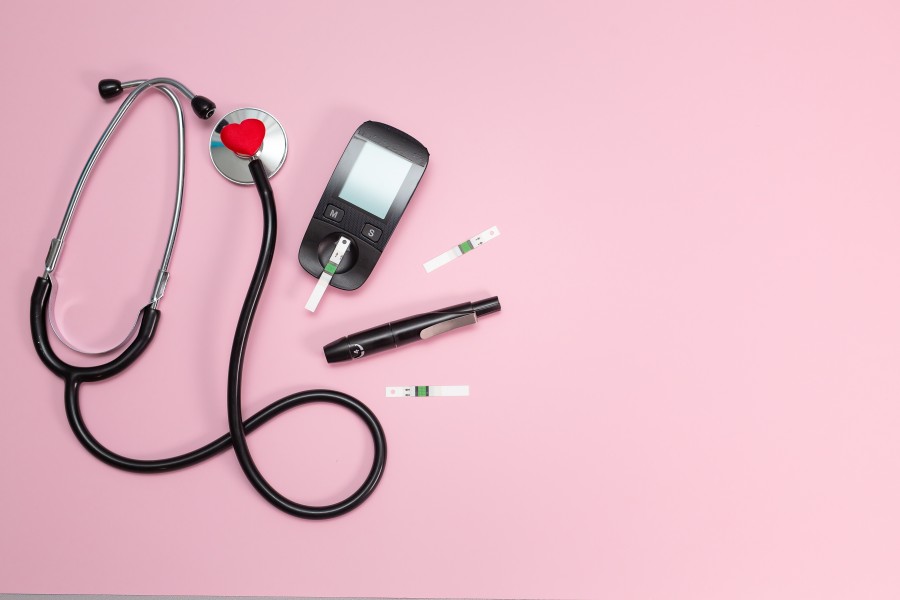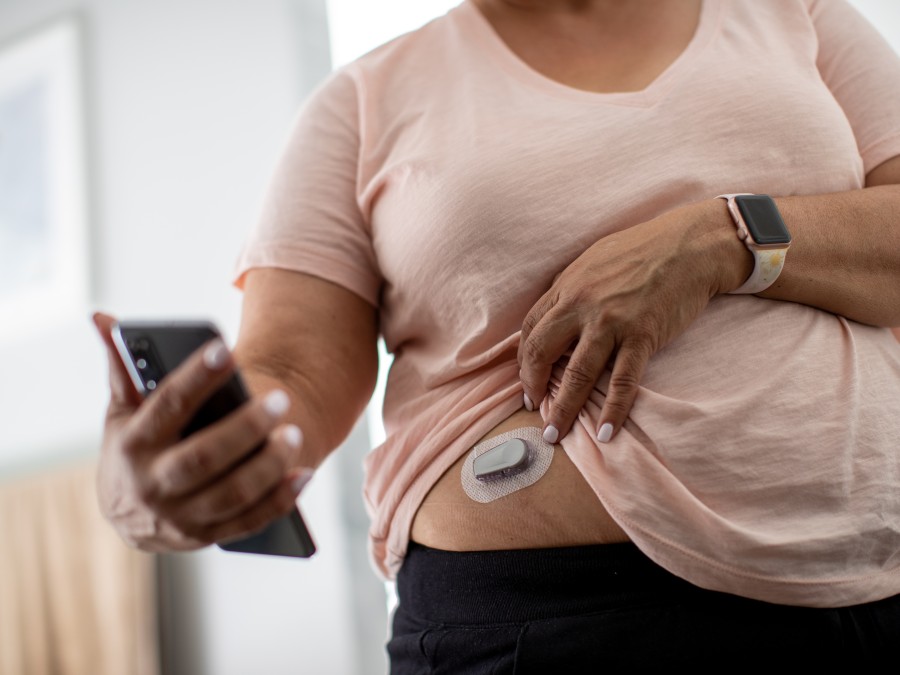Blood Glucose Meter and Continuous Glucose Monitor: What’s The Difference?

Blood Glucose Meter and CGM: What’s The Difference?
If you have been diagnosed with diabetes, you may need to monitor your blood glucose levels several times a day to reduce the chance of complications. You can do so in one of two ways: with a blood glucose meter (also known as a blood glucose monitor) or with a continuous glucose monitor (CGM).
How do these therapeutic tools work and which one should you choose? In this article, we compare the blood glucose meter with the CGM so that you can understand how each one works and contributes to managing blood glucose in daily life.
What is a blood glucose meter?
A blood glucose meter is a device that helps you measure the glucose levels in your blood. Glucose levels change in response to things like exercise, diet, medications or illness.
When you live with diabetes, understanding how your blood glucose fluctuates, and which activities or foods affect it, can help you and your healthcare professional come up with the most appropriate treatment plan for you.
A blood glucose monitor can tell you if your blood glucose is too high, too low, or within range. This way you can avoid episodes of hyper- or hypoglycaemia and prevent serious complications from diabetes.
Blood glucose meters need a tiny blood sample to detect glucose — usually, this is a droplet of blood taken from your fingertip.
How does a blood glucose meter work?
A blood glucose meter works by analysing a small droplet of blood from a test strip. The test strip contains a substance called glucose oxidase — an enzyme that reacts to blood glucose.
A small needle, called a lancet, is used to prick the finger and collect the small droplet of blood. Then, the droplet is placed on the testing strip, which is inserted into the blood glucose meter. Inside the blood glucose meter, there is an interface to an electrode, which is used to obtain a blood glucose reading. The reading is then displayed on a screen, in units of mg/dL or mmol/L.
When the strip goes inside the blood glucose meter, the glucose reaction from the enzyme generates an electrical signal. The higher the electrical current, the higher the glucose detected and the number appearing on the blood glucose meter’s screen.
Blood glucose meter: how to use
All blood glucose meters are slightly different, so following the instructions in the user manual is important.
However, generally, in order to use a blood glucose meter, you will mainly need:
-
A blood glucose meter
-
Testing strips
-
A single-use lancet or finger pricker
-
Soap and water or an alcohol prep wipe/swab
You should consult with your healthcare professional on the best time of the day to take the test, as well as the frequency of the tests. Also, although most blood glucose meters work by pricking the finger, some allow for the blood sample to be taken from your upper arm or thigh. Check the blood glucose meter’s manual for instructions on the testing site.
Your diabetes healthcare team will also be able to walk you through using a blood glucose meter.
What is the difference between a CGM and a blood glucose meter?
Continuous glucose monitoring (CGM) systems became commercially available in the year 2000 as an alternative to finger-prick testing. Unlike a blood glucose meter, a CGM does not require a blood sample .
What is a CGM and how does it work?
Generally speaking, a CGM consists of a monitor worn on the body with a thin needle-like sensor that is placed under the skin. This sensor obtains glucose readings from a person’s interstitial fluid, which is the fluid that fills the space between the cells and provides the body with nutrients.
The readings are either scanned manually or transmitted via Bluetooth to a receiver that displays and records the readings.
Continuous glucose monitors and blood glucose meters
It’s a good idea to understand and learn about the differences between a continuous glucose monitor and a blood glucose meter so that you can feel more informed about how they work when managing your own or someone else's diabetes. You may come across both of these devices during treatment, and it’s possible that both will be used at some stage.
Continuous glucose monitors
There are a number of advantages to using a CGM. Firstly, a CGM can record measurements as often as every five minutes, or 288 readings a day. With a CGM, you can observe changes in your blood glucose levels almost in real-time and receive alerts, which can help you take immediate steps to prevent a hyper- or hypoglycaemic episode. This gives it nearly 24/7 coverage of a person’s blood glucose patterns and an advantage at predicting and preventing low or high blood glucose episodes.
A CGM helps you gain insights into what happens when you are sleeping, when you are stressed, or engaged in other daily activities. It is particularly helpful for people who may have low blood glucose levels during the night and may be unaware.
Studies have linked CGM use with better metabolic control, a longer time spent in the recommended blood glucose range, less time in hypoglycaemia, and having lower anxiety and a better quality of life.
Continuous glucose monitors require training and time for the user to familiarise themselves with the device. CGMs still require a level of understanding and interaction in order to be effective in helping users to manage blood glucose levels.
It’s also important to note that certain models of CGM still require daily fingersticks for calibration when self-monitoring blood glucose (SMBG). The sensor is always on the body and requires regular replacement every 3–14 days, depending on model.
Blood glucose meters
Blood glucose meters take accurate measures of capillary glucose concentrations, providing results after a short testing time using only a small blood sample. A range of sites can be used for testing, to allow flexibility and variation.
They are widely used, and it can be simple to learn how to use them. Blood glucose meteres have a range of features — with some smart models having Bluetooth capabilities that can synchronise data with smartphone apps.
Frequent self-monitoring of blood glucose (SMBG) using blood glucose meters is considered a fundamental part of effective diabetes treatment and daily management. More frequent SMBG has been linked to lower HbA1c levels in people with type one diabetes and in insulin-treated patients with type 2 diabetes.
A blood glucose meter provides approximately 4–7 measurements a day. This means that a blood glucose meter offers more limited data compared to CGM, and therefore its clinical effectiveness is also limited. As they only provide information about a single point in time, it can be difficult to recognise trends in blood glucose levels over time.
Sources
- Kirk, Julienne K., and Jane Stegner. "Self-monitoring of blood glucose: practical aspects." Journal of diabetes science and technology 4.2 (2010): 435-439. https://journals.sagepub.com/doi/abs/10.1177/193229681000400225
- Mathew, Thomas K., and Prasanna Tadi. "Blood glucose monitoring." StatPearls [Internet] (2020). https://www.ncbi.nlm.nih.gov/books/NBK555976/
- “Blood glucose meters,” JDRF. Accessed February 8, 2022. https://jdrf.org.uk/information-support/treatments-technologies/blood-glucose-meters/
- Pickering, Dianne, and Janet Marsden. "How to measure blood glucose." Community eye health 27.87 (2014): 56. https://pdfs.semanticscholar.org/e244/68171435fd9d3e29ade58baf1f1da89fecc5.pdf
- “How do blood glucose meters work? Ask an engineer.” MIT School of engineering. Accessed February 8, 2022. https://engineering.mit.edu/engage/ask-an-engineer/how-do-blood glucose meters-work/
- Rodbard, David. "Continuous glucose monitoring: a review of successes, challenges, and opportunities." Diabetes technology & therapeutics 18.S2 (2016): S2-3. https://www.liebertpub.com/doi/full/10.1089/dia.2015.0417
- Baghelani, Masoud, et al. "Non-invasive continuous-time glucose monitoring system using a chipless printable sensor based on split ring microwave resonators." Scientific Reports 10.1 (2020): 1-15. https://www.nature.com/articles/s41598-020-69547-1
- Langendam, Miranda, et al. "Continuous glucose monitoring systems for type 1 diabetes mellitus." Cochrane Database of Systematic Reviews 1 (2012). https://www.cochranelibrary.com/cdsr/doi/10.1002/14651858.CD008101.pub2/full
- Funtanilla, Vienica D., Tina Caliendo, and Olga Hilas. "Continuous glucose monitoring: a review of available systems." Pharmacy and Therapeutics 44.9 (2019): 550. https://www.ncbi.nlm.nih.gov/pmc/articles/PMC6705487/
- Dovc, Klemen, and Tadej Battelino. "Evolution of diabetes technology." Endocrinology and Metabolism Clinics 49.1 (2020): 1-18. https://www.sciencedirect.com/science/article/pii/S088985291930091X
- Ajjan, Ramzi, David Slattery, and Eugene Wright. "Continuous glucose monitoring: a brief review for primary care practitioners." Advances in therapy 36.3 (2019): 579-596. https://link.springer.com/article/10.1007/s12325-019-0870-x




